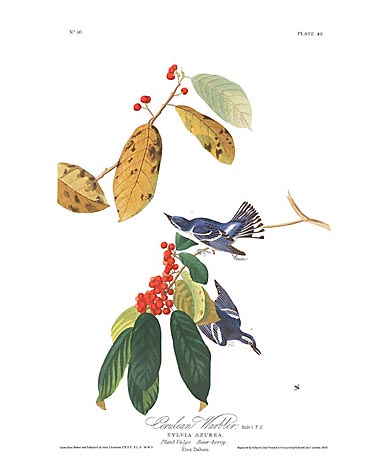|
Havell Name
Cerulean Warbler Common Name Cerulean Warbler Havell Plate No. 048 Paper Size 39" x 28" Image Size 16" x 11" Price $ 600 |
||||
|
Ornithological Biography So scarce is this bird in the Middle Districts, that its discovery in the State of Pennsylvania has been made a matter of much importance. Its habits are consequently very little known, even at the present day, and it would appear that only a few individuals have been seen by our American ornithologists, one of which, a young female, has been figured by the Prince of MUSIGNANO.
It arrives in the lower parts of the State of Louisiana, in company with many other species of Warblers, breeds there and sets out again about the beginning of October. It is as lively as most species of its genus, possesses the same manner of flight, moves sidewise up and down the branches and twigs, frequently changing sides, and hangs to the extremities of bunches of leaves or berries, on which it procures the insects and larvae of which its food is principally composed. The liveliness of its notes renders it conspicuous in those parts of the skirts of the forests which it frequents; and its song, although neither loud nor of long continuance, is extremely sweet and mellow. I have no precise recollection of the time when I first made a drawing of this pretty little bird, but know this well, that a drawing, which I had of it was one of the unfortunate collection destroyed by the rats at Henderson. In Louisiana, where it is as numerous as other Sylviae, I have several times shot five or six during a single walk, towards the end of August, when the young are nearly full coloured. The nest is placed in the forks of a low tree or bush, more frequently on a dog-wood tree. It is partly pensile, projecting a little above the twigs to which it is attached, and extending below them for nearly two inches. The fibres of vines and of the stalks of rank herbaceous plants, together with slender roots, compose the outer part, being arranged in a circular manner. The lining consists entirely of the dry fibres of the Spanish moss. The female lays four or five eggs, of a pure white colour, with a few reddish spots at the larger end. When the female is disturbed during incubation, she trails along the twigs and branches, with expanded tail and drooping wings, and utters a plaintive note, resembling in all these circumstances the Blue-eyed Warbler. I am not sure that they raise more than one brood in a season. When the young abandon the nest, their plumage partakes of a greenish tinge, and no difference can be perceived between the sexes without dissection. The little family move and hunt together, and exhibit much pleasure in pursuing small insects on wing, which they seize without any clicking sound of their bill. They seem at this period to evince a great partiality for trees the tops of which are thickly covered by grape vines, amongst the broad leaves of which they find ample supplies of food. They also sometimes alight on the tall weeds, and pick a few of their seeds. The males or females do not assume the full brilliancy of their plumage until the following spring. In the course of my late journey to the Texas I found the Azure Warbler entering the United States from Mexico, early in April, when it was in perfect plumage. On an island on which we landed, about an hour before sunset, some hundreds had stopped to pass the night, the appearance of the weather being threatening. My friend EDWARD HARRIS and my son shot a number of them. Next day few were seen, and in about a week they had all proceeded eastward. The whole breadth of our country, from the Atlantic shores to those of the Pacific, is visited by this bird, which was found along the Columbia river at Fort Vancouver by Mr. TOWNSEND. The most eastern point at which I have known it to be procured is the neighbourhood of Pictou, Nova Scotia. It is not mentioned by Dr. RICHARDSON. As to the Sylvia rara, my doubts regarding its specific distinction from Sylvicola coerulea, are as great as ever, especially as no one has found its nest. I mentioned this to the Prince of MUSIGNANO, who has placed it in his list as the young of Sylvia azurea. |
|||||
|
|
|||||


| Home | Gallery | Audubon Biography | About Edition | Testimonials | Authorized Dealers | Links | Contact Us |

© Copyright 2007-2025 Zebra Publishing, LLC. | All Rights Reserved Terms of Use
Powered by Fusedog Media Group
